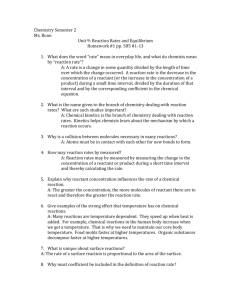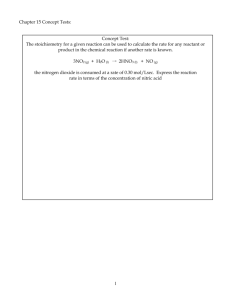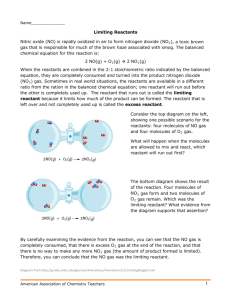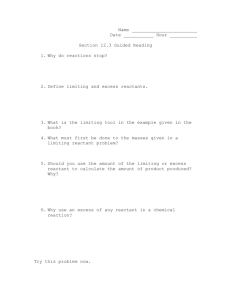Lecture 5_Kinetics
advertisement
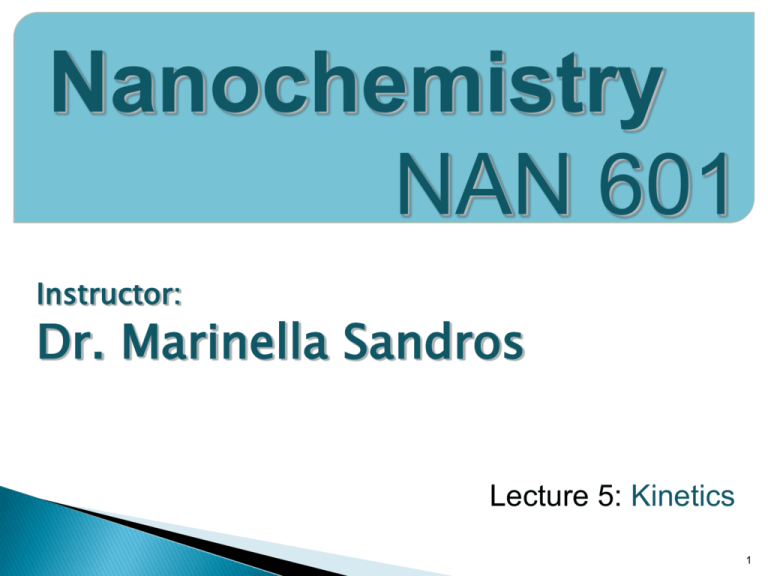
Nanochemistry NAN 601 Instructor: Dr. Marinella Sandros Lecture 5: Kinetics 1 Chemical Kinetics Thermodynamics – does a reaction take place? Kinetics – how fast does a reaction proceed? Reaction rate is the change in the concentration of a reactant or a product with time (M/s). A B [A] rate = t [A] = change in concentration of A over time period t [B] rate = t [B] = change in concentration of B over time period t Because [A] decreases with time, [A] is negative. Why are we interested in reaction rates? • If we wish to synthesize a new compound, or design a process for the industrial preparation of a valuable chemical substance, we would need to ensure that the reaction/s concerned take place at a reasonable rate. • Studies of the rates of chemical reactions can tell us an enormous amount about exactly how the reactions take place at the molecular level, i.e., such studies provide information about the reaction mechanism. 3 Factors that Affect Reaction Rate 1. Temperature • Collision Theory: When two chemicals react, their molecules have to collide with each other with sufficient energy for the reaction to take place. • Kinetic Theory: Increasing temperature means the molecules move faster. 2. Concentrations of reactants • More reactants mean more collisions if enough energy is present 3. Catalysts • Speed up reactions by lowering activation energy 4. Surface area of a solid reactant • Bread and Butter theory: more area for reactants to be in contact 5. Pressure of gaseous reactants or products • Increased number of collisions •The rate of a reaction could be monitored by measuring the increase in the amount of a reaction product with time. • Suppose that a substance A reacts to form B • For a reaction A→B 5 6 Suppose that – At t = 0 (time zero) there was 1.00 mol A (100 grey spheres) and no B present. 7 8 9 10 11 12 13 Br2 (aq) + HCOOH (aq) 2Br- (aq) + 2H+ (aq) + CO2 (g) slope of tangent slope of tangent slope of tangent [Br2]final – [Br2]initial [Br2] average rate = =t tfinal - tinitial instantaneous rate = rate for specific instance in time as opposed over an interval of time rate = k [Br2] rate = rate constant k= [Br2] = 3.50 x 10-3 s-1 The Rate Law The rate law expresses the relationship of the rate of a reaction to the rate constant and the concentrations of the reactants raised to some powers. aA + bB cC + dD Rate = k [A]x[B]y reaction is xth order in A reaction is yth order in B reaction is (x +y)th order overall Determination of order – Initial rate Method •A reaction is zeroth order in a reactant if the change in concentration of that reactant produces no effect. • A reaction is first order in a reactant if doubling the concentration of that reactant causes the rate to double. • A reaction is nth order in a reactant if doubling the concentration of that reactant causes an 2n increase in rate. • Note that the rate constant does not depend on concentration. 17 F2 (g) + 2ClO2 (g) 2FClO2 (g) rate = k [F2]x[ClO2]y Double [F2] with [ClO2] constant Rate doubles x=1 Quadruple [ClO2] with [F2] constant Rate quadruples y=1 rate = k [F2][ClO2] Run # Initial [A] ([A]0) Initial [B] ([B]0) Initial Rate (v0) 1 1.00 M 1.00 M 1.25 x 10-2 M/s 2 1.00 M 2.00 M 2.5 x 10-2 M/s 3 2.00 M 2.00 M 2.5 x 10-2 M/s What is the order with respect to A? 0 What is the order with respect to B? 1 What is the overall order of the reaction? 1 [NO(g)] (mol dm-3) [Cl2(g)] (mol 3) dm- Initial Rate (mol dm-3 s1) 0.250 0.250 1.43 x 10-6 0.250 0.500 2.86 x 10-6 0.500 0.500 1.14 x 10-5 What is the order with respect to Cl2? 1 What is the order with respect to NO? 2 What is the overall order of the reaction? 3 Rate Laws • Rate laws are always determined experimentally. • Reaction order is always defined in terms of reactant (not product) concentrations. • The order of a reactant is not related to the stoichiometric coefficient of the reactant in the balanced chemical equation. F2 (g) + 2ClO2 (g) 2FClO2 (g) rate = k [F2][ClO2] 1 22 23 First-Order Reactions • Rate depends on the concentration of a single reactant raised to the 1st power. [A] -kt rate = k [A] [A] = [A] e rate = 0 t [A] is the concentration of A at any time t [A]0 is the concentration of A at time t=0 ln[A] - ln[A]0 = - kt ln[A] = - k t + ln[A]0 Y= mX+ b •A graph ln [A] vs T gives a straight Line with a slope –k and a y-intercept of ln [A]0 25 26 27 28 Second-Order Reactions •Rate depends on the reactant concentration raise the second power or on the concentrations of two different reactants, each raised to the first power. [A] rate = t 1 1 = kt [A] [A]0 rate = k [A]2 [A] is the concentration of A at any time t [A]0 is the concentration of A at time t=0 Half life for second order t½ = t when [A] = [A]0/2 1 t½ = k[A]0 Zero-Order Reactions [A] rate = t [A] - [A]0 = kt rate = k [A]0 = k [A] is the concentration of A at any time t [A]0 is the concentration of A at time t=0 Half life for zero order t½ = t when [A] = [A]0/2 [A]0 t½ = 2k Summary of the Kinetics of Zero-Order, First-Order and Second-Order Reactions Order 0 Rate Law rate = k 1 rate = k [A] 2 rate = k [A]2 Concentration-Time Equation [A] - [A]0 = - kt ln[A] - ln[A]0 = - kt 1 1 = kt [A] [A]0 Half-Life t½ = [A]0 2k Ln 2 t½ = k 1 t½ = k[A]0 A+B C Experiment Number [A] (M) [B] (M) Initial Rate (M/s) 1 0.100 0.100 4.0 x 10-5 2 0.100 0.200 4.0 x 10-5 3 0.200 0.100 16.0 x 10-5 Using these data, determine (a) rate law for the reaction, (b) the magnitude of the rate constant; (c) the rate of the reaction when [A]= 0.050 M and [B]= 0.100 M. 32 Rate= k [A]2 [B]0 = k [A]2 K= Rate/ [A]2 = 4.0 x 10 Rate= k [A]2 = (4.0 x 10 -3 -3 M-1 s-1 M-1 s-1)(0.05 M)2=1.0 x 10-5 M/s 33





